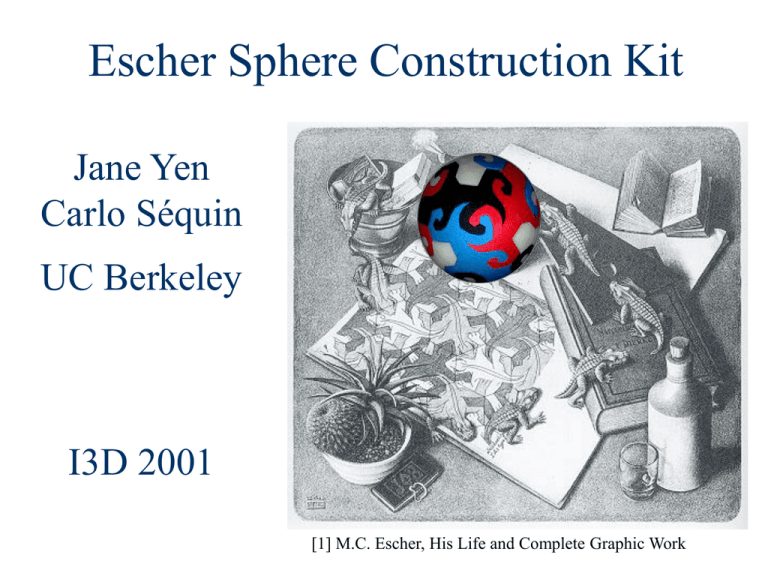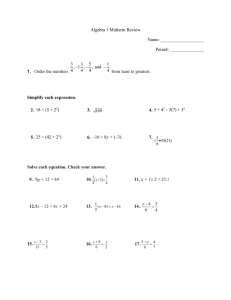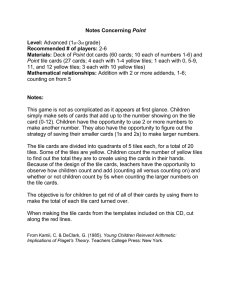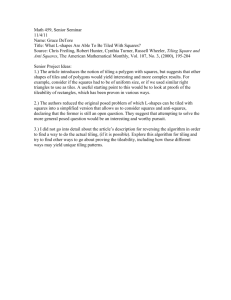Escher Sphere Construction Kit Jane Yen Carlo Séquin UC Berkeley
advertisement

Escher Sphere Construction Kit
Jane Yen
Carlo Séquin
UC Berkeley
I3D 2001
[1] M.C. Escher, His Life and Complete Graphic Work
Introduction
M.C. Escher
– graphic artist
& print maker
– myriad of
famous
planar tilings
– why so few
3D designs?
[2] M.C. Escher: Visions of Symmetry
Spherical Tilings
Spherical Symmetry is difficult
– Hard to understand
– Hard to visualize
– Hard to make the final object
[1]
Our Goal
Develop a system to easily design and
manufacture “Escher spheres” spherical balls composed of tiles
– provide visual feedback
– guarantee that the tiles join properly
– allow for bas-relief
– output for manufacturing of physical models
Interface Design
How can we make the system intuitive
and easy to use?
What is the best way to communicate
how spherical symmetry works?
[1]
Spherical Symmetry
The Platonic Solids
tetrahedron
R3
R5
octahedron
R3
cube
R5
dodecahedron
R3
icosahedron
R2
How the Program Works
Choose a symmetry based on a Platonic solid
Choose an initial tiling pattern to edit
= good place to start . . .
Example:
Tetrahedron:
2 different tiles:
R3
R2
R3
R3
R2
R2
R3
R3
R2
R3
Tile 1
Tile 2
Initial Tiling Pattern
+ Easy to understand consequences of moving points
+ Guarantees proper overall tiling
~ Requires user to select the “right” initial tile
– This can only make monohedral tiles (one single type)
[2]
Tile 1
Tile 2
Tile 2
Modifying the Tile
Insert and move boundary points (blue)
– system automatically updates all tiles based on symmetry
Add interior detail points (pink)
Adding Bas-Relief
Stereographically project tile and triangulate
Radial offsets can be given to points
– individually or in groups
– separate mode from editing boundary points
Creating a Solid
The surface is extruded radialy
– inward or outward extrusion; with a spherical or detailed base
Output in a format for free-form fabrication
– individual tiles, or entire ball
Video
Fabrication Issues
Many kinds of rapid prototyping technologies . . .
– we use two types of layered manufacturing:
Fused Deposition Modeling (FDM) Z-Corp 3D Color Printer
- parts made of plastic
- each part is a solid color
assembly
- plaster powder glued together
- parts can have multiple colors
FDM Fabrication
moving
head
Inside the FDM machine
support
material
Z-Corp Fabrication
de-powdering
infiltration
Results
FDM
Results
FDM | Z-Corp
Results
FDM | Z-Corp
Results
Z-Corp
Conclusions
Intuitive Conceptual Model
– symmetry groups have little meaning to user
– need to give the user an easy to understand starting place
Editing in Context
– need to see all the tiles together
– need to edit (and see) the tile on the sphere
• editing in the plane is not good enough (distortions)
Part Fabrication
– need limitations so that designs can be manufactured
• radial “height” manipulation of vertices
Future Work
– predefined color symmetry
– injection molded parts (puzzles)
– tessellating over arbitrary shapes (any genus)
Introduction to Tiling
Planar Tiling
– Start with a shape that tiles the plane
– Modify the shape using translation, rotation, glides, or mirrors
– Example:
Introduction to Tiling
Spherical Tiling - a first try
– Start with a shape that tiles the sphere (platonic solid)
tetrahedron
octahedron
cube
dodecahedron
– Modify the face shape using rotation or mirrors
– Project the platonic solid onto the sphere
– Example:
• icosahedron
• 3-fold symmetric triangle faces
icosahedron
Introduction to Tiling
Tetrahedral Symmetry - a closer look
• 24 elements: {E, 8C3, 3C2, 6sd, 6S4}
E
C2
C3
Identity
2-Fold
Rotation
3-Fold
Rotation
sd
Mirror
S4
Improper
Rotation
90° C2
+
Inversion (i)
Introduction to Tiling
What do the tiles look like?
C2
C3
C3
C2
C3
C2
C2
C3
M
Introduction to Tiling
Rotational Symmetry Only
• 12 elements: {E, 8C3, 3C2}
C2
C3
C3
C2
C2
C3
C3
C2
C3
Introduction to Tiling
Spherical Symmetry - defined by 7 groups
1) oriented tetrahedron
2) straight tetrahedron
3) double tetrahedron
4) oriented octahedron/cube
5) straight octahedron/cube
6) oriented icosa/dodeca-hedron
7) straight icosa/dodeca-hedron
Platonic
Solids
With Duals
12 elem: E, 8C3, 3C2
24 elem: E, 8C3, 3C2, 6S4, 6sd
24 elem: E, 8C3, 3C2, i, 8S4, 3sd
24 elem: E, 8C3, 6C2, 6C4, 3C42
48 elem: E, 8C3, 6C2, 6C4, 3C42, i, 8S6, 6S4, 6sd, 6sd
60 elem: E, 20C3, 15C2, 12C5, 12C52
120 elem: E, 20C3, 15C2, 12C5, 12C52, i, 20S6, 12S10,
12S103, 15s






